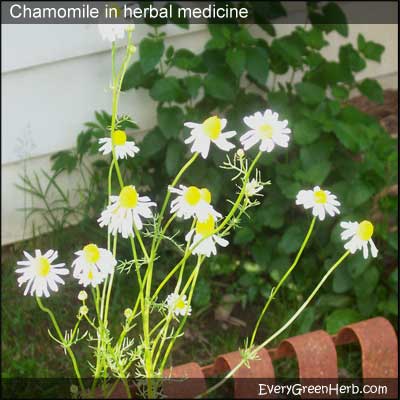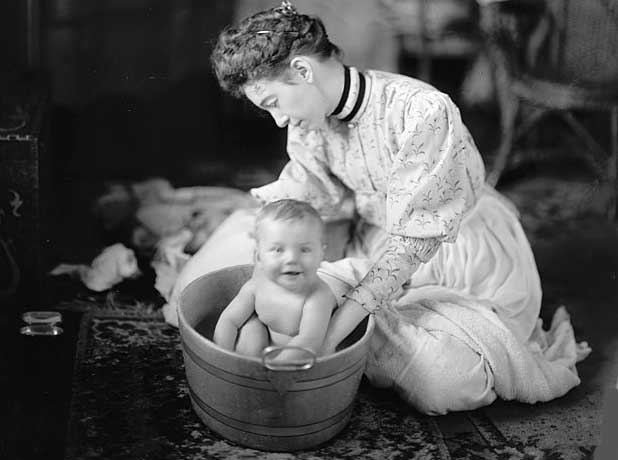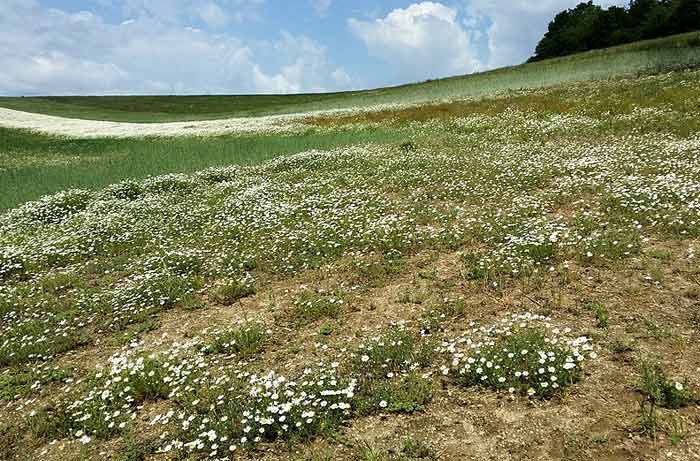Chamomile in natural remedies
German chamomile (Matricaria chamomilla) makes an excellent herbal tea and contains many healthy substances including bioflavonoids, luteolin, and quercetin.

Chamomile tea is good for acne, poor appetite, indigestion, heartburn, insomnia, anxiety, stress, headache, irritable bowel syndrome, and gallbladder problems. Read more about using natural methods to treat anxiety and stress related conditions.
Useful in herbal medicine
It is estimated that over a million cups of chamomile tea are consumed daily, making chamomile one of the most popular natural remedies in the world.
Chamomile skin tonics and ointments help heal insect bites, wounds, itching, and other skin irritations.
Chamomile essential oil has an aroma that resembles fresh apples. The scent is unique, dry, and fruity.
Chamomile essential oil is distilled from the flowering tops of the plant and is often used when treating digestion problems and sleep disorders like insomnia.
Chamomile can also lighten hair color and help itchy scalp problems. Chamomile tea is considered an excellent hair rinse and it keeps blonde hair shiny.
The oil is useful in massage for relieving muscular pain and helping the body to relax.
Chamomile tea is delicious. Known in herbal medicine as the herb that can treat anything, chamomile really is an amazing herb.

Chamomile tea is used in the treatment of everything from mouth sores to sprained ankles.
Strong chamomile tea makes a good mouthwash that relieves mouth ulcers and canker sores. It even helps control periodontal diseases. Add a pinch of myrrh powder for extra strength when treating the gums.
Inhaling the steam from a hot cup of chamomile tea not only calms the nerves, but can sooth hay fever, bronchitis, and asthma.
Used externally with witch hazel, it can even help eczema.
A chamomile compress can also ease sprained ankles and relieve inflamed joints. Read more about making your own herbal products at home.
Chamomile is used to dissolve gallstones.
Chamomile tea can help dissolve painful gallstones. Drink a cup of chamomile tea three times a day for three or four few weeks for best results. Chamomile supports gallbladder health naturally whether you have gallstones or not.
Chamomile tea helps stop nausea.
Chamomile tea, made from the dainty, white flowers of the plant, helps stop nausea and calms the stomach. Use with ginger for added strength.
Chamomile is also useful for relaxing the nerves in stressful situations. A cup of chamomile herbal tea is a great remedy for stress.
Unlike many herbal teas which taste bitter, chamomile tea is mild and even children like the taste.
Chamomile is a very healing herb.
Chamomile tea is one of the oldest herbal remedies and natural beauty products. The plant is originally from Europe and Western Asia.
Many Europeans use chamomile tea to treat eye infections such as pink-eye and blocked tear-ducts. To make an eye wash, brew a weak tea with dried chamomile flower tops and distilled water, strain through coffee filters, and apply the cooled liquid every few hours for a couple of days.
Many people find that chamomile improves the elasticity of the skin, thus improving an aging complexion by making it firmer and brighter. It is often used as a home remedy to get rid of acne. Drink chamomile tea, and use the tea as a wash for healthy, glowing skin.
German and Roman chamomile are both used in herbal medicine. The dried flower tops contain powerful terpenoids and flavonoids that are shown to help hay fever, inflammation, muscle spasms, menstrual problems, sleeping disorders, ulcers, wounds, arthritis pain, and hemorrhoids.
Chamomile flowers are used to make tea, tincture, essential oil, gargles, poultices, and compresses. Chamomile is also added to lotion for treating swelling and edema.
The plant is anti-inflammatory, antioxidant, astringent, and healing. It is an excellent choice for treating everything from diaper rash to cracked nipples and bed sores.
Use in pregnancy
During pregnancy, a weak chamomile tea can reduce morning sickness symptoms. When sipped slowly while nursing a baby, the tea can help prevent baby's colic.
It is also useful in the baby's bath to encourage a peaceful sleep. Just float a tea bag in the bath water.

Chamomile increases white blood cell production.
Chamomile is known to increase production of white blood cells which improves immunity in times of stress. Chamomile promotes a feeling of comfort, stimulates the memory, and helps overcome exhaustion.
Chamomile tea works internally and externally.
Chamomile tea shields ulcers, fights fungal invaders, soothes upset stomachs, helps mend torn tissue, kills staphylococcus and streptococcus bacteria, and generally protects and heals the body. This gentle herbal tea may even break dependencies on strong, over-the-counter laxatives by helping the digestive tract function properly.
Scientific studies
Studies show that volatile oils in chamomile flowers can penetrate below the skin surface where it heals and protects.
Chamomile has anti-cancer properties especially against prostrate cancer.
Chamomile has also been shown to help prevent bone loss in osteoporosis patients.
Chamomile is a mild tranquillizer and sleep-aid due to a flavonoid known as apigenin.

Chamomile essential oil is a rare treat.
Real chamomile essential oil is expensive. When chamomile is distilled into essential oil, the resulting liquid ranges in color from blue to green, but turns dark yellow with age.
Chamomile essential oil is used in baths, herbal lotions, massage, and aromatherapy to help treat PMS, menopausal symptoms, liver problems, cystitis, arthritis, toothache, stress, insomnia, and muscle inflammation.
Chamomile essential oil is also used to treat skin conditions like burns, blisters, and boils. It can even cure athlete's foot if used on a regular basis. For athlete's foot, add tea tree oil or garlic oil for extra strength.
Chamomile essential oil is a very useful home remedy.
Chamomile essential oil soothes the stomach, helps improve irritable bowel syndrome, stops diarrhea naturally, heals colic, stops vomiting, and helps improve jaundiced conditions.
Chamomile essential oil is used for skin problems.
Diluted chamomile essential oil can be used to help heal dandruff, herpes, dermatitis, psoriasis, and allergic conditions that cause skin problems.
Chamomile essential oil is used in aromatherapy.
The scent of chamomile essential oil is relaxing and removes all traces of tension and fear. It stimulates the mind, memory, and respiratory system. In Germany, chamomile is known as the herb that is capable of anything.

Grow your own chamomile in containers or herb bed.
Chamomile flowers are dainty and look like small daisies. The plant is a small evergreen perennial that forms a spreading mat of fine, feathery foliage about six inches high. Chamomile is easy to start from seed and can be propagated by cuttings.
Sow in full sun or partial shade, in light, well-drained moist soil. Do not let weeds take over the feathery plants.
Chamomile spreads rapidly if grown under the right conditions. Chamomile plants like a gravel or rock mulch.
Occasionally clip it with the mower to keep it under control.
The dainty, white flowers are harvested throughout the summer and then dried quickly to retain their rich properties for use in winter months.
Chamomile is gaining popularity as a cocktail in fine dining establishments.
Herbal cocktails are a new way to get the benefits of herbs into the body while having a night of fun. In this video, Naren Young shows us how to make a chamomile cocktail.
Chamomile fields in Iran
Chamomile is very popular in some parts of the world and festivals are held in its honor every year. The abundance and size of the Iranian chamomile is amazing.
I have trouble growing just a few plants here in the humid southern USA where weeds can smother the delicate chamomile plants in just a few days. We sure don't have to worry about Chamomile becoming an invasive species in North Georgia. That's for sure!
*Sometimes chamomile can trigger allergic reactions. Beware if you are allergic to rag weeds, asters, or chrysanthemums. Never use chamomile essential oil when pregnant. Do not take essential oils internally.
Always consult with a healthcare professional before using any herbal remedy especially if pregnant, nursing, or taking other medicines.
Sources:
https://www.ncbi.nlm.nih.gov/pmc/articles/PMC4740760/
https://www.ncbi.nlm.nih.gov/pmc/articles/PMC2995283/
Blessings to you and yours!
Thanks so much for reading my blog. Jan.

*Note - the information on this website has not been evaluated by the Food and Drug Administration.
© 2005-2024 website design and content by Janice Boling